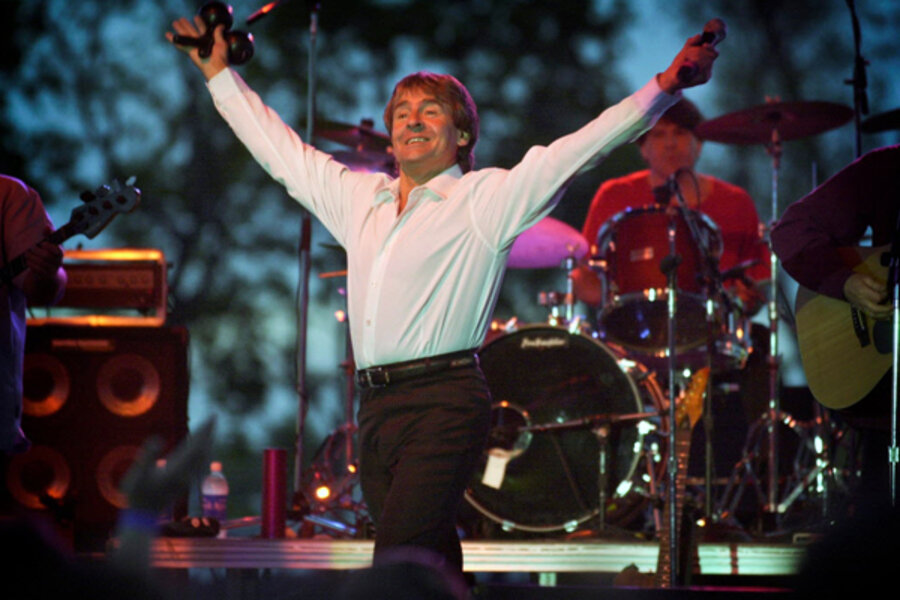Davy Jones, cast as lead singer for 'The Monkees,' was heartthrob for millions
| Los Angeles
British singer Davy Jones, most well known for his lead role in the American TV show, “The Monkees,” passed away at his Florida home Wednesday at the age of 66.
While he was an up-and-coming actor/singer, nabbing a Tony nomination for his role as the Artful Dodger in “Oliver!” he is known to millions as the heartthrob at the center of the popular TV show that ran from 1966 to 1968 and pioneered stylistic techniques that were exploited by other programs for years.
The program itself has a place in TV history for giving birth to what Fordham University media professor Paul Levinson calls the first musical group that was a complete creation of the television world.
“This was not a group that jammed in a garage or made a demo that somehow made its way to a studio executive,” he points out. “This was not a bunch of musicians that wrote their own music and hoped to be discovered like the Beatles or the Rolling Stones.”
Rather, the show was conceived as a TV pilot, and Mr. Jones, who was under contract to the studio, was cast as the lead singer. The remaining members of the band, Mickey Dolenz, Peter Tork, and Michael Nesmith were hired after Jones.
Despite being a media creation, points out Professor Levinson, the group sold real records to real fans. “It paved the way for all subsequent media creations that moved through the screen and out into the real world,” he says.
The program became a pop culture phenomenon, points out Robert Thompson, founder of the Bleier Center for Television and Popular Culture at Syracuse University in New York. The fantasy world of the four fictional characters “playing themselves,” hit a chord in the culture and touched millions of people, he points out.
“If you think of Justin Bieber and multiply that many times,” he says with a laugh, “that was the sort of impact Davy Jones had.”
This was partly due to the nature of popular media of the time. “It was not fragmented as it is today,” he says, so that when a singer or group caught on, “it became a merchandising-machine dream.” The Monkees logos were virtually everywhere, from comics to shirts and, Prof. Thompson points out, “they sold millions of records.”
Part of the show’s appeal came from its ability to ride the newly breaking wave of experimental creativity with the medium of popular television.
While many may not necessarily associate the concept of groundbreaking with the pop-candy music of the Monkees – with such songs as “I’m a Believer” – Thompson says the show pushed the creative envelope for its day. “It had all these quick cuts and a narrative that was fundamentally surreal,” says Thompson. “The actors didn’t even necessarily move in believably human ways,” he says, adding that the urge to be “groovy and hip was helping create a new visual aesthetic.”
These were techniques that would be exploited in everything from “the Smothers Brothers Comedy Hour” to “Rowan and Martin’s Laugh-In,” to “Sesame Street.”
The stylistic techniques that made “the Monkees” such a distinctive pop culture destination found full flower much later in MTV, which didn’t debut until 1981, notes Thompson.
While Jones left the group in late 1970, he maintained a place in the heart of young female fans with such iconic moments as his 1971 appearance on “The Brady Bunch,” answering Marcia Brady’s dream of having the singer appear at her high school dance.
MTV later aired “The Monkees” during the 1980s, creating a new generation of fans for the group, which reunited for a tour in the same decade.
“The Monkees” are the only artists to have four No. 1 albums in the same year. The TV show won two Emmys, and the group had 12 Billboard Top 40 singles – among them “I'm a Believer,” “Last Train to Clarksville,” “Daydream Believer,” “Stepping Stone,” and “I Wanna Be Free.”






